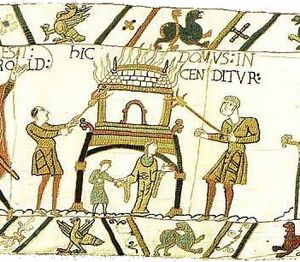Burning of Southwark facts for kids
Quick facts for kids Burning of Southwark |
|||||||
|---|---|---|---|---|---|---|---|
| Part of the Norman Conquest of England | |||||||
 A scene from the Bayeux tapestry depicting the (earlier) burning of an Anglo-Saxon house |
|||||||
|
|||||||
| Belligerents | |||||||
| Duchy of Normandy | Kingdom of England | ||||||
| Commanders and leaders | |||||||
| Duke William of Normandy | Ansgar the Staller | ||||||
| Strength | |||||||
| 500 cavalry | |||||||
The Burning of Southwark was a battle that happened in Southwark, England, in October 1066. This event was part of the larger Norman Conquest of England.
Soldiers from Normandy, led by William, Duke of Normandy, fought against Anglo-Saxon soldiers. The fight was for control of London Bridge, a key crossing over the River Thames into London. The Normans won the battle but then pulled back from Southwark. They faced strong local resistance. As they left, they set the town on fire to scare the people. Southwark was badly damaged. After this, William marched west. He cut off London's supply routes, which eventually made the city surrender to him.
Contents
Why Did the Battle of Southwark Happen?
William, Duke of Normandy, started his invasion of England in September 1066. He believed he should be the next king. This was after the death of the Anglo-Saxon King Edward the Confessor, who had no children.
After King Edward died in January 1066, Harold Godwinson was made king. But other powerful people also wanted the throne. Harold had defeated his other rivals by late September. This left William's invasion as his last big challenge.
The Battle of Hastings and London's Defense
On October 14, William's forces won the Battle of Hastings. King Harold was killed in this battle. William then moved towards London, England's capital. The Anglo-Saxon leaders in London had chosen Edgar Ætheling as their new king.
William expected London to surrender easily. He sent a small group of cavalry (soldiers on horseback) to Southwark. Southwark was a very important town. It held the southern end of London Bridge, which was the main way to get into London. At that time, Southwark was a partly fortified (protected) town. It was also part of King Harold's family lands.
Who Fought in the Battle?
Some people in London supported William, but many others wanted to fight the Norman invaders. The local Anglo-Saxon forces were led by Ansgar the Staller. He was a royal standard bearer and a sheriff.
Ansgar had been hurt while fighting for King Harold at the Battle of Hastings. But he returned to London to help organize its defense. Even though his injuries were severe, he gathered a large and strong force of Londoners. William offered Ansgar a deal: he could keep his lands and job if he accepted William as king. Ansgar refused.
The Fight for London Bridge
Ansgar led the London citizens against the Norman soldiers in Southwark. Other important Anglo-Saxon leaders might have been there too. The 500 Norman knights defeated Ansgar's Anglo-Saxon force. They managed to reach London Bridge.
However, the Normans were surprised by how fiercely the defenders fought. They could not hold the bridge and soon pulled back. As they retreated, the Normans set Southwark on fire. They did this to spread fear among the people of London, who were just across the river. Almost the entire town was destroyed. This included the Southwark mint, which made coins. It took many years for the mint to recover.
What Happened After the Battle?
Because of the strong defense at Southwark, William decided not to attack London directly. The Norman soldiers who had fought in Southwark rejoined William's main army. The army then began a long march around the west side of London.
This area was strongly against the Normans. William found that many river crossings on the River Thames were guarded. He avoided some towns and eventually reached Wallingford. There, he crossed the river after getting help from a Saxon leader named Wigod. William then split his army into two groups. He led one group north, and the other marched through different towns.
London Surrenders to William
William's forces cut off the supply routes to London. This meant no food or goods could easily reach the city. This, along with the burning of Southwark and William's talks with leaders in Kent, led to London's surrender.
William had also been talking with important church leaders in London. They helped convince the Anglo-Saxon leaders of the city to support William. These leaders traveled to meet William and promised to be loyal to him. They gave him the keys to the city gates. William entered London peacefully. He was crowned King of England at Westminster Abbey on Christmas Day.


